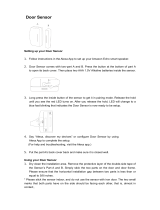
2
Table of Contents
Features........................................................................................................2
Home Screen................................................................................................3
Temperature Dial Feature ......................................................................... 3
Screen Elements ...................................................................................... 3
System Settings...........................................................................................7
Wi-Fi .........................................................................................................7
Name ........................................................................................................8
Away ......................................................................................................... 8
True Temp ............................................................................................... 10
Fan .........................................................................................................10
Ventilation ............................................................................................... 10
Heat & Cool ............................................................................................ 11
Humidity ..................................................................................................12
Comfort Sync Zoning .............................................................................. 13
Notications (Reminders Only) ............................................................... 13
Energy Savings ...................................................................................... 14
Advanced Settings .................................................................................. 15
General ................................................................................................... 15
Display .................................................................................................... 16
Home Info ...............................................................................................17
Account ...................................................................................................18
Notications (Critical, Warnings and Reminders) .................................. 18
Comfort Sync Zoning Operations ............................................................ 19
Heating / Cooling Changeover ............................................................... 19
Damper Operation .................................................................................. 19
Dual-Fuel Operation ............................................................................... 19
Emergency Heat Operation - Heat Pump Systems ............................... 19
Home Screen Zone Navigation .............................................................. 19
Using the Secure Web Portal ...................................................................20
Amazon Alexa and Google Assistant ...................................................... 20
Amazon Alexa .........................................................................................20
Google Home and Assistant ................................................................... 21
FCC Statements .........................................................................................22
FCC Compliance Statement — PART 15.19 ..........................................22
FCC Interference Statement — PART 15.105 (B) .................................. 22
RF Exposure Information ........................................................................22
Comfort Sync A3 Thermostat App .......................................................... 22
Index ...........................................................................................................24
Features
This Comfort Sync A3 thermostat is an electronic communicating, color display
touchscreen and 7-day programmable interface which communicates directly
with a Smart Hub Controller. After on-line registration is completed, the system
may then be accessed by the homeowner from anywhere via computer or
mobile device (Internet connection required).
Comfort Sync Features include:
• Three languages supported (English, Français and Español)
• Wi-Fi Connected
• Away Sync® - Uses the thermostat to control the home temperature while
unoccupied (geo-fencing)
• True Temp® - Controls the system using outdoor / indoor temperatures and
indoor humidity to create the optimal comfortable conditions in the home
• Climate SyncTM - Monitors current climate conditions and automatically
removes excess humidity when necessary (requires Allied communicating
outdoor unit)
• Schedule Sync feature, allows you to program the thermostat once.
Whenever there’s a change in your routine, the thermostat adapts heating
and cooling to match
• Temp Hold (Single Set Point) - In non-zoning applications this allows a single
temperature setting to be used to cool or heat the home
• Air conditioning or heat pump units with up to four stages of heat / two stages
of compressor operation (two stages of heat pump heating, two stages of
auxiliary back-up heating and two stages of emergency heating)
• Variable - capacity / multiple - stage Heat • Cool, universal compatibility (gas/
electric/heat pump/air conditioner)
• Dual-fuel capable (Allied communicating heat pump only) with two balance
points
• Humidication measurement and dew point adjustment controls
• Heat • Cool mode -- Permits control of heating, cooling, humidication, and
dehumidication without user involvement
• Enhanced Performance reports are available through the homeowner web
portal
• Equipment maintenance reminders
• Screen saver picture upload
This thermostat works with:
• Amazon® Alexa, and Google AssistantTM
• Indoor air quality with time based notication of consumables including media
lters, UVC bulbs, humidier pads, and system catalyst service / replacement
• Comfort Sync zoning system (2 - 4 zones)




















